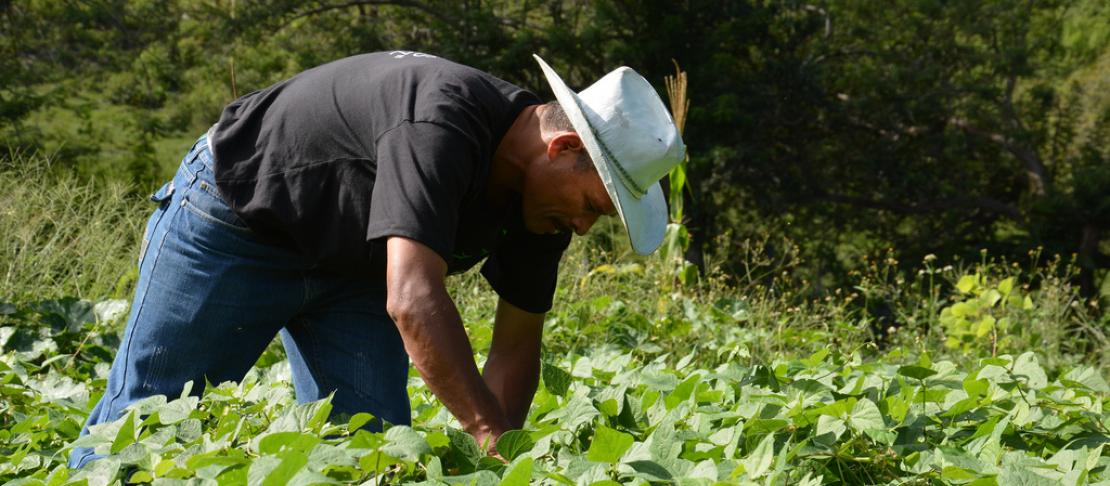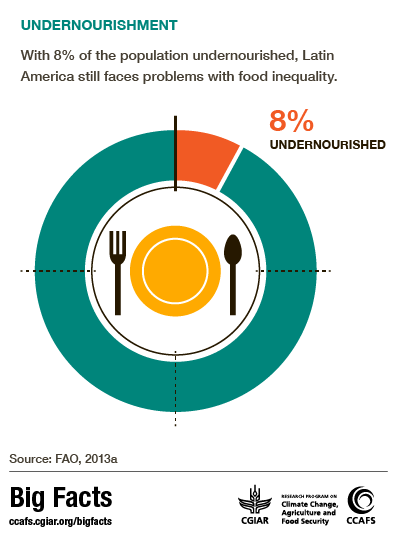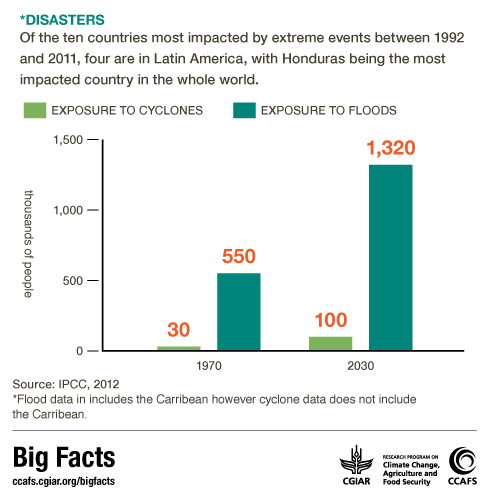Big Facts: Focus on Latin America

This story highlights some of the Big Facts around climate change, agriculture and food security for Latin America, and is part of a month-long series that complements the new Big Facts website.
As climate change unfolds around the world, we take a closer look at its effects on food and farming in Latin America and the Caribbean. This region is particularly vulnerable to extreme weather events, which not only threatens people’s safety, but can also damage crops and natural resources, which form the backbone of the regional economy. Investing in healthy ecosystems may pay off in terms of long-term resilience. The region is also a big emitter of greenhouse gases, due to deforestation and an expansive livestock industry. The good news is there are many opportunities to reduce emissions.
Food Security
The number of undernourished people in Latin America and the Caribbean has declined, in part thanks to increases in food production and economic growth in the region in recent decades. The share of undernourished people declined from 14.6% to 8.3% between 1990-92 and 2010-12 (FAO, 2012), and the share is expected to decrease over time to 2.5% in 2050 (Alexandratos and Bruinsma 2012: 27). However, 8% of the population is still undernourished, which is a serious problem, and many countries in the regions suffer from inequality and unequal access to food.
Ironically, overnutrition is also on the rise with resulting negative impacts on health. According to the UN Food and Agriculture Organisation, the increasing number of overweight and obese people poses a larger problem than the number of underweight people in Latin America and the Caribbean (FAO 2013: 18).

Emissions
A significant share of greenhouse gas (GHG) emissions related to agriculture stem from deforestation activities. Compared to other regions of the world, South America suffered the largest net loss of forests between 2000 and 2010: about 4 million ha per year. In Brazil, deforestation is estimated to be responsible for more than 50% of GHG emissions (Cerri et al., 2010).
Emissions from other food-related activities, especially livestock rearing, are also on the rise. Diets are relatively rich in animal protein and dairy, and by 2050, Latin America’s per capita meat consumption (84 kg per person per year) is expected to be on par with high-income countries (91 kg per person per year). As diets rich in animal products generally carry heavier emission loads, this could result in increasing dietary emissions.
Story: Read about livestock production in Brazil.
Impacts on People
Extreme weather events already have severe impacts on people in the region, and will most likely become more severe as climate change progresses, leading to changes in the intensity and/or frequency of these events. Extreme events have hit the region particularly hard: four out of the ten most impacted countries are from Latin America and the Caribbean, based on the 1992 to 2011 ranking of the Long-term Climate Risk Index. Find out more about the challenges faced by the so-called CA-4 countries here. What’s more, the number of people susceptible to these events is projected to increase in the coming decades, as can be seen from the figure below.

Impacts on crops
As in any other region, climate change is expected to have an impact on crop production. In the drier areas of Latin America and the Caribbean, climate change is expected to lead to increased salinity and desertification of agricultural land. In the zone known as the 'dry corridor', climate change has already forced people to 'climb up' the mountains to maintain their crop yields. The Intergovernmental Panel on Climate Change in its 2007 assessment found that productivity of some important crops could decrease (e.g. maize), though large regional differences were found, while other crops could benefit from a changed climate (e.g. soybean); livestock productivity is expected decline, and yields of the economically important coffee crop could decline in many parts of the region. If these impacts are not mitigated, it could have adverse consequences for food security in the region. Changes in precipitation patterns and the disappearance of glaciers are projected to significantly affect water availability for human consumption, agriculture and energy generation, though the melting of glaciers might not have an impact until the end of the century, if impacts are similar to those found in Asia.
Adaptation
Latin America is heavily dependent on its natural resources and the functioning of its ecosystems for exports of products, e.g. timber, crops, and livestock products. 61% of total exports in Latin America in 2011 were primary products and raw materials, and the economic growth of the region is highly dependent on exports that are derived from natural resources. Thankfully, research on the ground is already showing how we can develop agricultural intensification while at the same time preserving the health of our ecosystems. One of the challenges will be to convince people from the region of the synergies between adaptation and mitigation. As Laura Meza, FAO's Senior Consultant points out:
there is substantial overlap between sustainable land management practices that can increase capacity for adaptation and allow the mitigation of greenhouse gases.”
Another important adaptation approach to increase climate resilience in Latin America will be to reduce the degradation in ecosystem through the development and strengthening of policy (IPCC AR4, Magrin et al. 2007).
Mitigation
South America is suffering large losses of forest (FAO, 2011). Deforestation causes a significant amount of GHG emissions in the region, so reducing deforestation will be an important mitigation strategy (Locatelli et al., 2010).
Besides this, there is significant potential to reduce emissions from agricultural activities. Brazil is a large producer of cattle; in 2011 it accounted for around 14% of global cattle meat production (FAOSTAT, 2013). Livestock enteric fermentation, that is, methane emissions stemming from the congestion of food by livestock, was the third biggest contributor to GHG emissions in Brazil and the largest contributor of methane emissions. The methane emissions originated in Latin America’s agricultural sector is large compared to other regions; 66.3% of total methane emissions in Latin America in 2010 came from the agricultural sector, the average for the world is 42%. Measures to mitigate emissions include increasing the quality of pastures and improving feed quality.
This short post is by no means an exhaustive overview of the various issues related to climate change and agriculture in Latin America. I invite you to dig deeper into the various facts and graphics on the site and explore the differences and similarities between the different regions. In each of the thematic sections, numerous references are given, should you want to explore a topic further. As always, if you have any comments or questions, these are most welcome.
Now you can get all the Big Facts on the links between climate change, agriculture and food security at ccafs.cgiar.org/bigfacts2014. The new site features over 100 stunning infographics that illustrate the most up-to-date, thoroughly researched information on these topics.
Big Facts is also an open-access resource. You can download and share the graphics with your friends and colleagues and use them in your presentations and reports. Please do not hesitate to send us any suggestions for improvements, either by commenting below or sending us an email.
This story is part of a series focusing on the Big Facts on various topics and in different regions; join the conversation at ccafs.cgiar.org/blog and on twitter using #bigfacts



